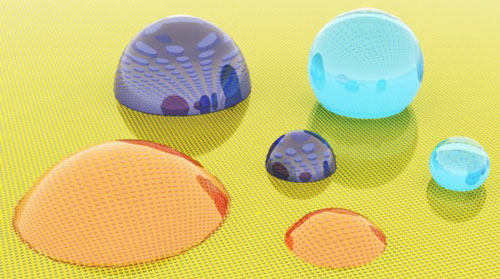2.5 Nano-engineered friction
Initial attempts at producing synthetic gecko tape – trying to copy the gecko's adhesive paws – were performed by nanoindenting followed by the molding of silicone (PDMS) in nanoindented cavities. Other fabrication techniques for producing biomimetic dry adhesive fibers soon followed and included electron beam lithography, plasma etching, and photolithography.
While some groups have concentrated their efforts on developing new fabrication techniques that allow increased fiber density, other researchers have examined the effects of fiber tip shape, fiber aspect ratio, and the addition of an overhanging cap. Still others have tried to mimic the structures found on geckos by developing hierarchical structures (read more about this in our last chapter), which increase the ability of the gecko fibers to conform to a surface.
In a different achievement, researchers have developed the first nano/micro-textured highly slippery surfaces able to outperform lotus leaf-inspired liquid repellent coatings, particularly in situations where the water is in the form of vapor or tiny droplets (see: "A nanoengineered surface unsticks sticky water droplets").
Whereas the Lotus effect is based on the tiny micro- and nanotextures on its surface, which does not work well for organic or complex liquids, the pitcher plant takes a fundamentally different approach: It locks in a water layer, creating a slick coating on the top. In short, the fluid itself becomes the repellent surface.
Adopting the pitcher plant's slick strategy, scientists have created a material that repels just about any type of liquid, including blood and oil, and does so even under harsh conditions like high pressure and freezing temperatures (see: "Slippery slope: biocoating researchers take advice from carnivorous plant").
A great example of the benefits of such a non-stick coating can be found in food packaging. It is estimated that up to 15 percent of bottled condiments are ultimately thrown away because they stick to container sides (think ketchup bottle or toothpaste tube). Keeping bottles clean could also drastically cut the use of water and energy, as well as the costs associated with rinsing bottles before recycling.
Liquid-impregnated coating technologies such as LiquiGlide developed in 2009 by MITís Kripa Varanasi and David Smith, or SLIPS (Slippery Liquid-Infused Porous Surfaces), developed in 2011 by Joanna Aizenberg's lab at Wyss Institute, involve nanoscale texturing of a surface, which is then coated with a – usually lubricating – liquid.
SLIPS are designed to expose a defect-free, molecularly flat liquid interface, immobilized by a hidden nanostructured solid. On these ultra smooth slippery surfaces fluids and solids alike – including water drops, condensation, frost, and even solid ice – can slide off easily.
Enhancing the mobility of liquid droplets on rough surfaces has wide-ranging benefits. Liquid-impregnated coatings, when applied inside a container, act as a slippery barrier between the container surface and a viscous liquid, say ketchup. The coating clings permanently to the container's sides, while allowing the condiment to glide off completely, with no residue.
Some applications that would see gains in effectiveness or efficiency are:
• Water harvesting in arid regions, where collecting fog droplets on coated meshes provides drinking water and irrigation for agriculture.
• Airplane safety in frosty conditions, where the prevention of icing and frosting on aircraft wings is a major issue. Unlike lotus leaf-inspired ice phobic surfaces, which fail under high humidity conditions, SLIPS-based ice phobic materials can completely prevent ice formation at temperatures slightly below 0°C while dramatically reducing ice accumulation and adhesion under deep freezing, frost-forming conditions (see: "A new spin on antifreeze").
• Fuel- and water-transport pipes or medical tubing (such as catheters and blood transfusion systems), which are sensitive to drag and pressure and are compromised by unwanted liquid-surface interactions.
• Self-cleaning surfaces for building maintenance, where faÁades and windows are big aesthetical and cost factors.
• Surfaces that resist bacteria and other types of fouling (such as the buildup that forms on ship hulls).
• Condensation heat transfer for heat exchangers in power plants, where the build-up of fouling reduces system performance.
• Safety of electronic devices by making their surface superhydrophobic so that they can't be damaged by moisture.
• Anti-sticking surfaces that repel fingerprints or graffiti.

Of course there are areas where engineers want to increase, rather than reduce, friction of a mechanical system. Automobile tires are a good example. For tires there is a classic performance conundrum among traction, tire life and fuel efficiency. Improving one quality almost always degrades another.
Ideally, a perfect tire would minimize rolling resistance, which improves fuel efficiency, while maximizing the sliding friction that basically helps to brake quickly and avoid skidding.
Already, researchers are working on this problem by creating structures at the micro- and nanoscale that will enhance friction and adhesion control (see: "Bio-inspired tire design: Where the rubber meets the road"). The results are increased sliding friction that could enhance a tire's grip, as forward energy is released from the tire's surface to dissipate as harmless heat and sound waves. At the same time there is barely any increase in adhesion, so rolling resistance isn't increased.
Science notes: Friction at the nanoscale
Key takeaways
• While there are clear laws of friction that apply on the macroscale, the precise mechanisms underlying friction at the nanoscale are still not completely understood.
• Friction at the nanoscale becomes far more complicated than friction at the macroscale because different processes and mechanisms can contribute to energy losses during sliding and thus lead to friction.
• Engineers are copying Nature's designs for reducing macro- and nanoscale friction.
Vocabulary
• Van der Waals forces: Weak electrostatic forces that attract neutral molecules to one another.
• Superlubricity: A recently invented term in tribology, which is generally defined as the state, at which the friction coefficient is near zero.
• NEMS, or nanoelectromechanical systems, are devices in which the physical motion of a nanoscale structure is controlled by an electronic circuit, or vice versa.
• MEMS are mechanical and electro-mechanical elements (i.e., devices and structures) that are made by microfabrication techniques and are microscale in size.
